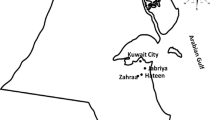Abstract
Five strains ofEscherichia coli O157:H7 were isolated from 486 stool specimens collected in 1986, 1987, and 1988 from patients with diarrhea in Xuzhou City, Jiangsu Province, China; 21 of the specimens were from patients with bloody diarrhea. The biochemical reactions of all five strains were almost identical with those of the well-knownE. coli O157:H7 strain 933. All of the strains were found to carry a 60 Md plasmid and two small plasmids. The plasmid DNA Hind 111 restriction patterns were identical. The strains were lysed byE. coli typing phage E1, E2, and E3, but not by E4 or E5. Data suggested that it might belong to a single phage or plasmid group. All strains produced vero toxin and caused diarrhea and death in infant rabbits and mice.
Similar content being viewed by others
Literature Cited
Ahmed R, Bopp C, Borezyk A, Kasatiya S (1987) Phagetyping scheme forEscherichia coli O157:H7. J Infect Dis 155:806–808
Gransden WR, Damm MAS, Anderson JD, Cater JE, Lior H (1986) Further evidence associating hemolytic uremic syndrome with infection by verotoxin producingEscherichia coli O157:H7, J Infect Dis 154:522–524
Harris AA, Kaplan RL, Goodman LJ, Doyle M, Landau W, Segreti J, Mayer K, Levin S (1985) Results of a screening method used in a 12-month stool survey forEscherichia coli O157:H7. J Infect Dis 152:775–777
He X-Q, Wu H-M, Sun J-C, Zhang S-Z, Chen A-F, Lu P-H (1983) Diagnostic phages of the genusEscherichia [in Chinese]. Chinese J Microbiol Immun 3:264–269
Karch H, Heesemann J, Laufs R, O'Brein AD, Tacket CO, Levine MM (1987) A plasmid of enterohemorrhagicEscherichia coli O157:H7 is required for expression of a new fimbrial antigen and for adhesion to epithelial cells. Infect Immun 55:455–461
Konowalchuk J, Speirs JI, Stavric S (1977) Vero response to a cytotoxin ofEscherichia coli. Infect Immun 18:775–779
March SB, Ratnam S (1986) Sorbitol-MacConkey medium for detection ofEscherichia coli O157:H7 associated with hemorrhagic colitis. J Clin Microbiol 23:869–872
Morgan GM, Newman C, Palmer SR, Allen JB, Shepherd W, Rampling AM, Warren RE, Gross RJ, Scotland SM, Smith HR (1988) First recognized community outbreak of haemorrhagic colitis due to verotoxin-producingEscherichia coli O157:H7 in the U K. Epidem Inf 101(1):83–93
Myers LL, Shoop DS, Firehammer BD, Border MM (1985) Diarrhea due toEscherichia coli O157:H7 in the infant rabbit. J Infect Dis 152:1341–1346
Padhye VV, Beery JT, Kittell FB, Doyle MP (1987) Colonic hemorrhage produce in mice by a unique vero cell cytotoxin from anEscherichia coli strain that causes hemorrhagic colitis. J Infect Dis 155:1249–1253
Pai CH, Gordon R, Sims HV, Bryan LE (1984) Sporadic cases of hemorrhagic colitis associated withEscherichia coli O157:H7. Ann Intern Med 101:738–742
Pai HC, Kelly JK, Meyers GL (1986) Experimental infection of infant rabbits with verotoxin-producingEscherichia coli. Infect Immun 51:16–23
Ratnam S, March SB, Ahmed R, Bezanson GS, Sakatiya S (1988) Characterization ofEscherichia coli O157:H7. J Clin Microbiol 26:2006–2012
Remis RS, MacDonald KL, Riley LW, Puhr ND, Wells JG, Davis BR, Blake PA, Cohen ML (1984) Sporadic cases of hemorrhagic colitis associated withEscherichia coli O157:H7. Ann Intern Med 101:624–626
Riley LW (1987) The epidemiologic, clinical and microbiologic features of hemorrhagic colitis. Annu Rev Microbiol 41:383–407
Riley LW, Remis RS, Helgerson SD, McGee HB, Wells JG, Davis BR, Hebert RJ, Olcott ES, Johnson LM, Hargrett NT, Blake PA, Cohen ML (1983) Hemorrhagic colitis associated with a rareEscherichia coli serotype. N Engl J Med 308:681–685
Wells JG, Davis BR, Wachsmuth IK, Riley LW, Remis RS, Sokolow R, Morris GK (1983) Laboratory investigation of hemorrhagic colitis outbreaks associated with a rareEscherichia coli serotype. J Infect Dis 18:512–520
Xu J-G, Liu H-M (1989) Plasmid DNA restriction patterns as a tool for epidemiological investigation of hemorrhagic colitis caused byEscherichia coli O157:H7 [abstr]. Abstracts of International Scientific Conference on Epidemiology, April 24–26, Beijing, China, p 175
Xu J-G, Qi G-M (1988) The microbiological, epidemiologic and clinical features of enterohemorrhagicEscherichia coli [in Chinese]. Chinese J Epidem 9:174–177
Author information
Authors and Affiliations
Rights and permissions
About this article
Cite this article
Xu, JG., Quan, TS., Xiao, DL. et al. Isolation and characterization ofEscherichia coli O157:H7 strains in China. Current Microbiology 20, 299–303 (1990). https://doi.org/10.1007/BF02091909
Issue Date:
DOI: https://doi.org/10.1007/BF02091909




